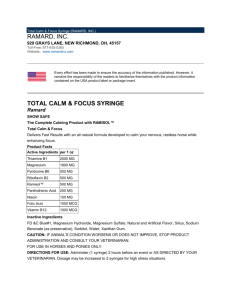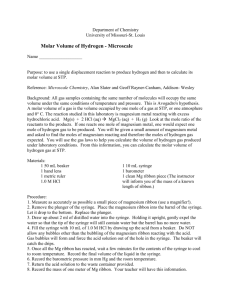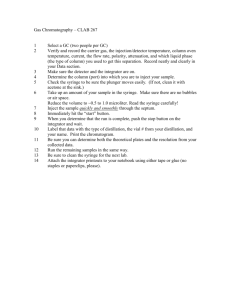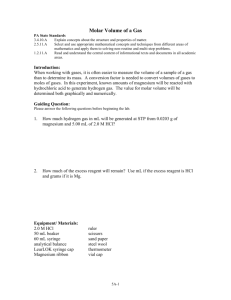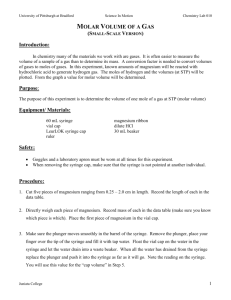Molar Volume of a Gas Lab: Chemistry Experiment
advertisement
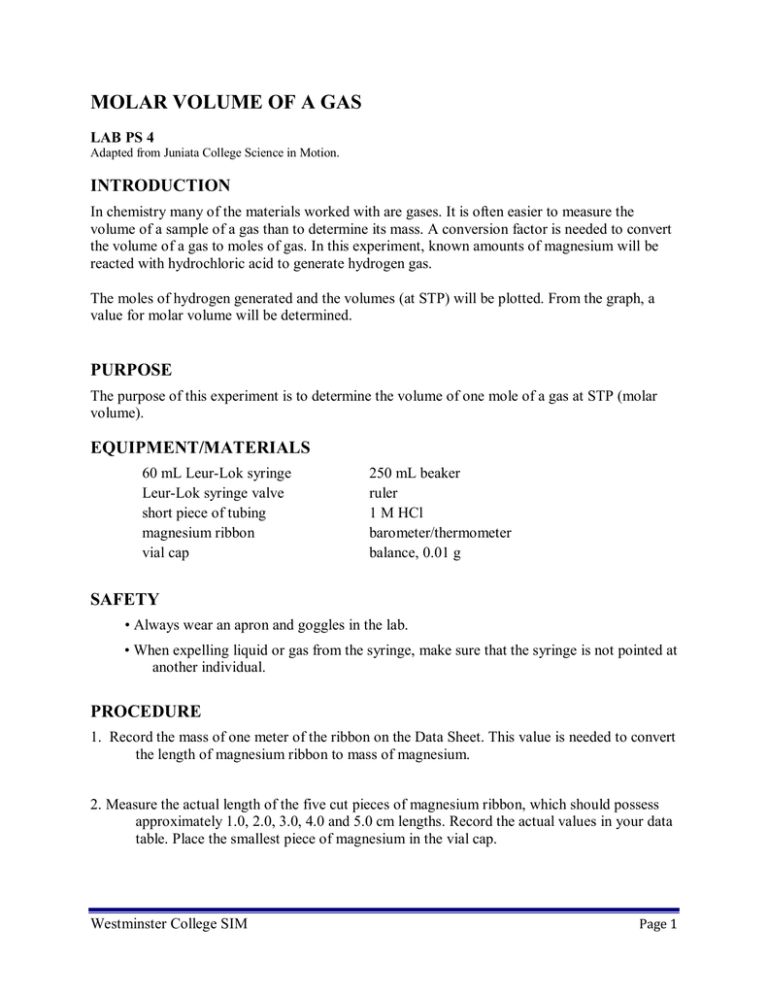
MOLAR VOLUME OF A GAS LAB PS 4 Adapted from Juniata College Science in Motion. INTRODUCTION In chemistry many of the materials worked with are gases. It is often easier to measure the volume of a sample of a gas than to determine its mass. A conversion factor is needed to convert the volume of a gas to moles of gas. In this experiment, known amounts of magnesium will be reacted with hydrochloric acid to generate hydrogen gas. The moles of hydrogen generated and the volumes (at STP) will be plotted. From the graph, a value for molar volume will be determined. PURPOSE The purpose of this experiment is to determine the volume of one mole of a gas at STP (molar volume). EQUIPMENT/MATERIALS 60 mL Leur­Lok syringe Leur­Lok syringe valve short piece of tubing magnesium ribbon vial cap 250 mL beaker ruler 1 M HCl barometer/thermometer balance, 0.01 g SAFETY • Always wear an apron and goggles in the lab. • When expelling liquid or gas from the syringe, make sure that the syringe is not pointed at another individual. PROCEDURE 1. Record the mass of one meter of the ribbon on the Data Sheet. This value is needed to convert the length of magnesium ribbon to mass of magnesium. 2. Measure the actual length of the five cut pieces of magnesium ribbon, which should possess approximately 1.0, 2.0, 3.0, 4.0 and 5.0 cm lengths. Record the actual values in your data table. Place the smallest piece of magnesium in the vial cap. Westminster College SIM Page 1 Molar Volume of a Gas 3. Hold the syringe vertically and make sure that the plunger moves smoothly in the barrel of the syringe. Remove the plunger, close the valve connected to the syringe and fill the syringe with tap water. Float the vial cap with the magnesium on the water in the syringe, open the valve and let the water drain into a waste beaker. When all the water has drained from the syringe, replace the plunger and push it into the syringe as far as it will go. Note the reading on the syringe here: ________ mL. 4. Draw 5 mL of the hydrochloric acid into the syringe by placing the tubing into the 1 M HCl bottle and pulling the plunger up until the liquid is at the 5 mL line. Close the syringe valve. Record the volume after drawing up the acid as the Initial Volume in the Data Table. 5. Turn the syringe horizontal and not pointed at anyone, shake it so that the acid and magnesium react. Note: As the reaction takes place, the hydrogen gas produced will push the plunger up the barrel of the syringe. 6. When the reaction is done, record the Final Volume in the Data Table. Subtract the Initial Volume to find the “Actual H Volume”. 2 7. Invert the syringe. Making sure that the syringe is not pointed at anyone, carefully open the syringe valve. Drain the liquid into a waste beaker. 8. Repeat steps 1­7 with the each sample of magnesium ribbon. 9. Write and balance equation for this reaction. Westminster College SIM Page 2 Molar Volume of a Gas DATA SHEET Name ________________________ Name ________________________ Period _______ Class ___________ Date ___________ MOLAR VOLUME OF A GAS DATA Mass of 1.00 meter of magnesium ribbon ________ g Mass per cm of magnesium ________ g/cm Room Temperature ________ °C = ________ K Barometric Pressure ________ DATA TABLE Trial Length Mass Moles Moles Final Initial Mg Mg Mg H Volume Volume 2 (cm) (g) (mL) (mL) Actual H 2 Volume (mL) Volume H , 2 Molar Volume of H (L/mole) 2 STP (L) 1 2 3 4 5 Westminster College SIM Page 3 Molar Volume of a Gas CALCULATIONS Complete for one of your trials: (assume that the HCl is in excess) 1. Show the calculation of: a. The mass of magnesium used b. The moles of magnesium used c. The moles of hydrogen formed d. The actual H volume 2 2. Complete the following table: Your experiment STP P P V V T T 1 = _______________ 2 = _______________ 1 = _______________ 2 = _______________ 1 = _______________ 2 = _______________ 3. Use the combined gas law to calculate the volume of hydrogen (liters) collected at STP. Westminster College SIM Page 4 Molar Volume of a Gas 4. Calculate the molar volume of hydrogen QUESTIONS 1. What is the limiting reactant in this reaction? 2. What are some possible sources of error in this experiment? 3. What is your % error? Westminster College SIM Page 5
